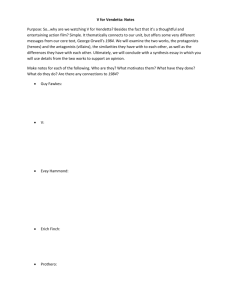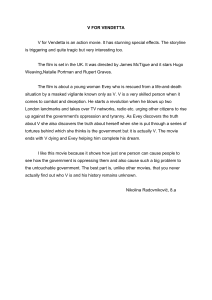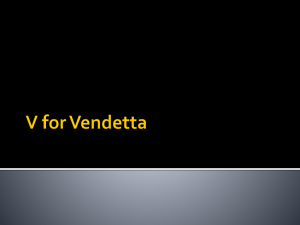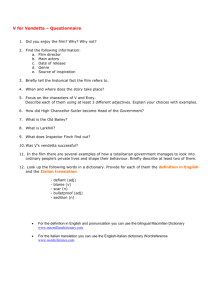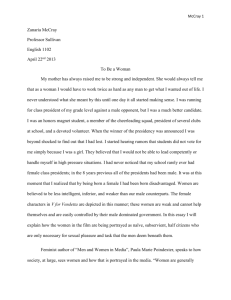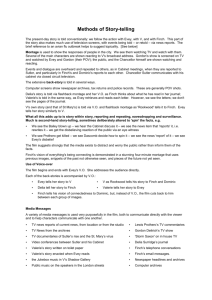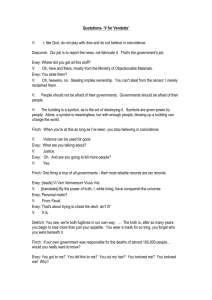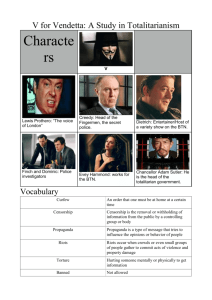After the First Viewing
advertisement
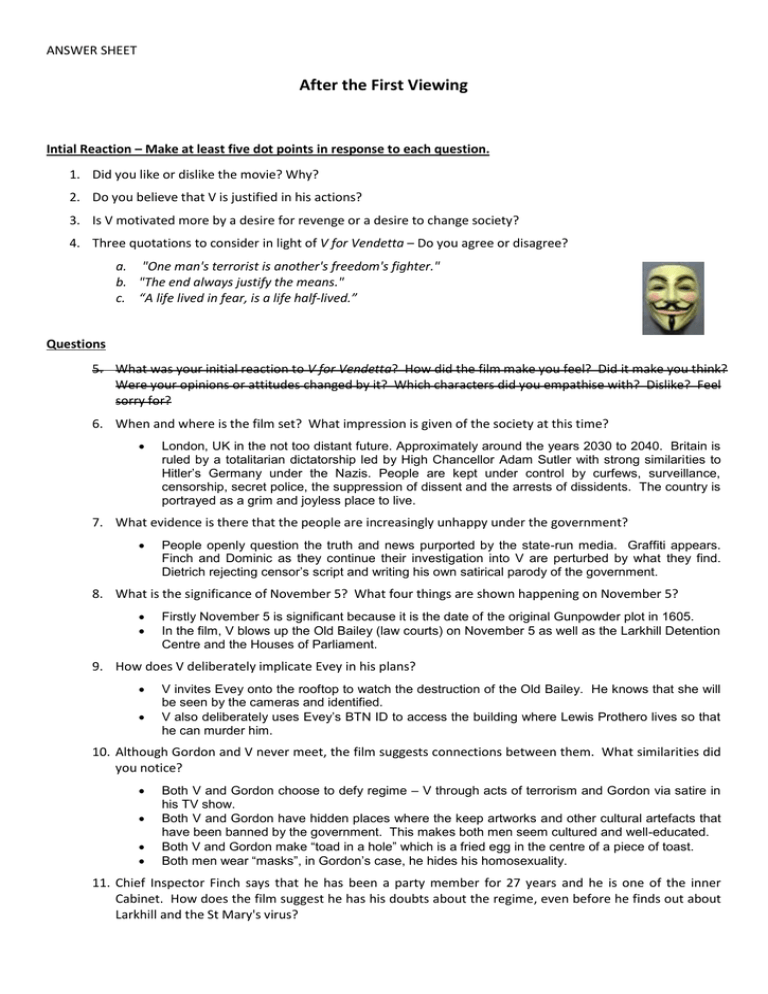
ANSWER SHEET After the First Viewing Intial Reaction – Make at least five dot points in response to each question. 1. Did you like or dislike the movie? Why? 2. Do you believe that V is justified in his actions? 3. Is V motivated more by a desire for revenge or a desire to change society? 4. Three quotations to consider in light of V for Vendetta – Do you agree or disagree? a. "One man's terrorist is another's freedom's fighter." b. "The end always justify the means." c. “A life lived in fear, is a life half-lived.” Questions 5. What was your initial reaction to V for Vendetta? How did the film make you feel? Did it make you think? Were your opinions or attitudes changed by it? Which characters did you empathise with? Dislike? Feel sorry for? 6. When and where is the film set? What impression is given of the society at this time? London, UK in the not too distant future. Approximately around the years 2030 to 2040. Britain is ruled by a totalitarian dictatorship led by High Chancellor Adam Sutler with strong similarities to Hitler’s Germany under the Nazis. People are kept under control by curfews, surveillance, censorship, secret police, the suppression of dissent and the arrests of dissidents. The country is portrayed as a grim and joyless place to live. 7. What evidence is there that the people are increasingly unhappy under the government? People openly question the truth and news purported by the state-run media. Graffiti appears. Finch and Dominic as they continue their investigation into V are perturbed by what they find. Dietrich rejecting censor’s script and writing his own satirical parody of the government. 8. What is the significance of November 5? What four things are shown happening on November 5? Firstly November 5 is significant because it is the date of the original Gunpowder plot in 1605. In the film, V blows up the Old Bailey (law courts) on November 5 as well as the Larkhill Detention Centre and the Houses of Parliament. 9. How does V deliberately implicate Evey in his plans? V invites Evey onto the rooftop to watch the destruction of the Old Bailey. He knows that she will be seen by the cameras and identified. V also deliberately uses Evey’s BTN ID to access the building where Lewis Prothero lives so that he can murder him. 10. Although Gordon and V never meet, the film suggests connections between them. What similarities did you notice? Both V and Gordon choose to defy regime – V through acts of terrorism and Gordon via satire in his TV show. Both V and Gordon have hidden places where the keep artworks and other cultural artefacts that have been banned by the government. This makes both men seem cultured and well-educated. Both V and Gordon make “toad in a hole” which is a fried egg in the centre of a piece of toast. Both men wear “masks”, in Gordon’s case, he hides his homosexuality. 11. Chief Inspector Finch says that he has been a party member for 27 years and he is one of the inner Cabinet. How does the film suggest he has his doubts about the regime, even before he finds out about Larkhill and the St Mary's virus? At the first meeting with the High Chancellor, Finch mouths the slogan “England prevail” rather than say it as loudly as the others. Finch often uses a scrambler when talking to Dominic so as to keep his conversations private from the surveillance trucks. Finch says to Dominic that he would like to “speak” to Evey before she disappears into “one of Creedy’s black bags”. Finch is the only member of the inner cabinet to oppose the High Chancellor and make alternative suggestions. 12. How does Evey change during the course of the film? How is this shown? Evey’s physically appearance – at the start of the movie, she has long feminine hair, wears makeup, but comes across as easily frightened and almost childlike. By the end of the movie, Evey has a shaven head and walks taller as she is no longer afraid. When she attempts to run away from V, she is dressed like a child which represents her development at this point of the novel. 13. Why is V not ever shown without his mask? V says to Creedy in their final confrontation, “Beneath this mask there is more than flesh. Beneath this mask there is an idea, Mr Creedy, and ideas are bullet proof.” By deliberately not giving V a name nor a face, the director enables him to become a symbol of rebellion against the Norsefire regime. 14. V murders several characters associated with his time at the Larkhill Detention Centre, yet the death of Delia Surridge differs significantly? Why? Unlike Prothero and Bishop Lilliman, Delia Surridge is aware of what she did at Larkhill to V and the other inmates and feels incredible remorse. It is for this reason, that her death is less painful and more peaceful than Prothero’s and the Bishop’s. 15. At the end of the film, several characters that died during the narrative are shown when the Guy Fawkes masks are removed. Why? How does it add to the symbolism of the final scenes? The final scenes of V for Vendetta are deliberately symbolic as many characters who have died during the narrative are shown in the crowd at the Houses of Parliament. By featuring characters like Dietrich and Valerie in the crowd, the director is reminding the audience that you cannot kill an idea and that the deaths of these characters were not in vain and can lead to regime change. When we watch a film for the first time, we usually watch for the story; when we see it again, we are more likely to notice how the story is told. However, you may already have noticed some of the striking techniques used. 16. Make a note of any significant techniques you remember seeing. You might think about lighting, camera angles, special effects, or the use of sound and music. Use of music – eg. Destruction of the Old Bailey accompanied by the 1812 Overture, added to the drama of the scene Use of colour – eg. Red / V’s Shadow Gallery warmly coloured Lighting – at the inner cabinet meeting, each member is individually lit Use of similar camera shots to connect elements in the movie, use of camera angles to demonstrate power relations. 17. The letter V is ubiquitous (everywhere) in the film. How many examples can you remember? V’s cell number at Larkhill was ‘V’ (number 5) The dominoes spell out ‘V’ At the end of the destruction of the Old Bailey and the Houses of Parliament, the fireworks shoot up in a V pattern Beethoven’s 5th symphony is played when he blows up parliament V slashes the letter ‘V’ into the propaganda poster The flags appear in a V shape in the nursing home The girl with glasses graffiti’s V onto the propaganda posters Creedy fires only five shots at V Evey’s bruise/cut in the shape of a V High Chancellor has a v-shaped cut at the end of the movie. E is the fifth letter in the alphabet and V is five letters from the end…. V quotes from Shakespeare and speaks in iambic pentameter V changes the logo of BTN to VTV. 18. Besides the letter V, the director uses a range of different symbols and motifs as part of the story? Can you identify at least three and where you saw them in the movie? 19. The film employs a number of different ways of telling the story. What different methods did you notice? Different characters tell part of the story through voice-over narration o Valerie narrates her letter o Dr Delia Surridge narrates her diary o Inspector Finch states what he thinks might happen o Evey narrates the story of the gunpowder plot o V tells part of the story when he pretends to be William Rookwood Flashbacks are used to give characters and the plot background – Valerie, Evey, V Media – news clips and other media reports Inspector Finch – detective story The symbol of the girl with glasses, helps the viewer understand the wider impact of V’s actionsl BOOKLET 2 DESIGN AND SETTING 1. When and where is the film set? How do you know? o o o o o o 2. What is revealed about the society at this time? How is this revealed? 3. Setting is a futuristic version of London, England (approx. 2030) British setting evident through use of icons like Big Ben, Houses of Parliament and the Old Bailey BTN – British Television Network Accents of the main characters Slogan “England Prevails!” English phrases like “bollocks” When V impersonates William Rookwood, he is able to explain how the High Chancellor and his party came to power through a climate of fear after St Mary’s terrorist attack, which is later revealed to be an act of the government. Often film-makers use settings to reveal important details about a character and their personality? Consider the following characters and what each setting reveals about them? 1. V and his Shadow Gallery 2. Evey and her bedsit 3. V’s Shadow Gallery is full of books, especially banned books. V has stolen from the Ministry of Objectionable Material banned artworks and sculptures. He has a shrine for Valerie, who he wishes to avenge. V has a kitchen where he makes “eggy in a basket” for Evey. V is literary, cultured and quintessentially English in some ways. Various artefacts from theatres and other venues Minimal interior, cheap furniture Very few personal items apart from a couple of photos Suggests that she is someone who travels light and for some reason is afraid of accumulating things that she could later lose High Chancellor Sutler meets with the inner cabinet High Chancellor is depicted on a huge TV screen, where he is a bombastic, dominant, largerthan-life figure He is rude and expects to be obeyed and brokers no dissents. 4. Dietrich and his mansion. Dietrich lives in a wealthy area of London, as he is a successful TV star He has a hidden room that like V’s Shadow Gallery is full of cultural artefacts including a banned picture of the High Chancellor and a14th Century Koran GENRE AND ALLUSION 4. What elements of both science-fiction and dystopian fiction does V for Vendetta have? 5. The character of Gordon Dietrich is played by the well-known British actor and comedian, Stephen Fry. What is unique about his background that make him a clever choice to play Dietrich? 6. Stephen Fry is a well-known gay comedian and actor, who had a troubled youth, and is now an advocate for gay rights. Our knowledge of Stephen Fry’s background adds to the strength of his characterisation of Dietrich. The film, V for Vendetta, deliberately connects the Norsefire regime with totalitarian regimes from both history (ie. Nazi Germany) and fiction (1984 by George Orwell). Can you find at least five examples where these connections are made? 7. Science-fiction elements – speculation about future events makes allusions to past historical events; good (V, Evey) vs Evil (Norsefire, High Chancellor, Creedy and the Fingerman); surveillance requires the use of specialised trucks and scrambling devices; V is a super-hero with increased agility, speed and pain tolerance When V (impersonating William Rookwood) recounts the story of the High Chancellor’s rise to power, flashbacks are shown of the High Chancellor giving a speech with soldiers marching in front that evoke memories of similar photographs of Adolf Hitler and the Nazis. Both Hitler and Suttler use similar means ie. Fear to rise to power Footage of the concentration camps in V for Vendetta is very similar to photos of Auchwitz and other camps. In both camps, the prisoners’ heads are shaven and they are subjected to medical experiments. Like in Nazi Germany, minorities, opposition activists and homosexuals are sent to the concentration camps The Fingerman are a secret police service like the SS and Gestapo Propaganda, censorship and the media is used to manipulate the public Norsefire logo is geometric and coloured in a way reminiscent of a Nazi swastika. It also is very similar to the French facist party logo in WW2 Nazis and Norsefire ban art that they see as degenerate High Chancellor’s name is Adam Suttler, which echoes Adolf Hitler. Other allusions Phantom of the Oera Zorro The Count of Monte Cristo 1984 by George Orwell Shakespeare and performance Literary allusions Deliberately use contemporary footage of riots to make allusion to current events What is the effect of such allusions on the viewer? How do they affect your overall understanding of the text? By likening the Norsefire regime to Hitler under the Nazis, the director creates a sense of familiarity for the viewer despite this being a science-fiction. This is because the reader has a basic understanding of Nazism and relies on this knowledge to fully understand V for Vendetta. STYLES OF FILM-MAKING SEE POWERPOINT MOTIF AND SYMBOL 1. Look at this list of motifs and symbols in the film and complete the activitiy. MOTIF OR SYMBOL a) Letter “V” b) Guy Fawkes c) Color red d) Masks e) Black bags f) Fire and rain g) Old Bailey and Houses of Parliament h) Girl with glasses EXAMPLE - Specific examples from the text? WHICH ONE? Is it a motif or a symbol? SYMBOLISM - If it is a symbol, what does it represent? CHARACTERISATION As we work through each scene, remember to also consider how the film techniques contribute to the viewer’s understanding of each character and their nature: CHARACTERS ROLE IN THE TEXT – DEPICTION – CHANGE – Evey Hammond V Finch High Chancellor Adam Sutler Creedy Gordon Dietrich protagonist/ antagonist; hero/villian; sympathetic; easy to identify with; point of view; victim/perpatrator costuming, acting style and dialogue setting, framing and camera work Does the character change? If so, how? KEY IDEAS AND TECHNIQUES V for Vendetta is a thought-provoking film that aims to challenge the viewer through several central ideas. Look at each idea listed, and think of at least two examples of its portrayal in the movie and an appropriate techniques. KEY IDEAS MESSAGE – What does the film have to say about this idea? 1. Political Ideas – V for Vendetta as dystopian fiction 2. Truth and lies 3. Masks and identity 4. Story-telling EXAMPLES Find at least two examples TECHNIQUES USED How are these ideas conveyed through at least two techniques. USEFUL QUOTATIONS What are some of the key quotations and phrases that stood out to you? Use the supplied list and highlight the ones you find important? What themes (central ideas) from V for Vendetta are reinforced in these quotations. 1. V: 2. V: [Quoting Polonius from Hamlet, III,i] "We are oft to blame in this, - / 'Tis too much proved - that with devotion's visage/ And pious action we do sugar o'er/ The devil himself." A more perfect stage could not be asked for. 3 4 V: It is to Madame Justice that I dedicate this concerto. Tell me Evey, do you know what day it is? Evey: November 4. V: [Big Ben starts to chime] Not anymore. Remember, remember the 5th of November. The gunpowder, treason, and plot. I know of no reason why the gunpowder treason should ever be forgot. 4 3. Sutler: Spare us your professional annotations, Mr Finch. They are irrelevant. 5 4. Sutler: Gentlemen, I want this terrorist found... and I want him to understand what terror really means. 5 5. Dascomb: Our job is to report the news, not fabricate it. That's the government's job. 6 6. BTN Worker: Do you believe that load of bollocks? There was no demolition. I saw the whole thing. 6 7. Finch: I just want a chance to talk to her before she disappears into one of Creedy's black bags. 11 8. BTN News: Now, this is only an initial report, but at this time, it's believed that during this heroic raid, the terrorist was shot and killed. Little Glasses Girl: Bollocks. 15 9. Evey: Where did you get all this stuff? V: Oh, here and there, mostly from the Ministry of Objectionable Materials. Evey: You stole them? V: Oh, heavens, no. Stealing implies ownership. You can't steal from the censor; I merely reclaimed them. Evey: God, if they ever find this place... V: I suspect if they do find this place, a few bits of art will be the least of my worries. 17 10. V: People should not be afraid of their governments. Governments should be afraid of their people. 19 11. V: The building is a symbol, as is the act of destroying it. Symbols are given power by people. Alone, a symbol is meaningless, but with enough people, blowing up a building can change the world. 19 12. Prothero: The moral of the story is: Good guys win. Bad guys lose. And as always: England prevails. 20 13. Finch: When you're at this as long as I've been, you stop believing in coincidence. 24 14. V: 25 [as The Count of Monte Cristo ends] Did you like it? Evey: Yeah. But it made me feel sorry for Mercedes. V: Why? Evey: Because he cared more about revenge than he did about her. 15. V: Evey: V: Evey: V: Violence can be used for good. What are you talking about? Justice. Oh. And are you going to kill more people? Yes. 25 16. Evey: My father was a writer. You would've liked him. He used to say that artists use lies to tell the truth, while politicians use them to cover the truth up. V: A man after my own heart. 28 17. Evey: I wish I wasn't afraid all the time, but... I am. 28 18. Deitrich: You see, we're both fugitives in our own way. … The truth is, after so many years, you begin to lose more than just your appetite. You wear a mask for so long, you forget who you were beneath it. 36 19. Guard: It's time. Evey: I'm ready. Guard: Look all they want is one little piece of information. Just give them something, anything. 51 Evey: Thank you, but I'd rather die behind the chemical sheds. Guard: Then you have no fear any more. You're completely free. 20. Evey: I can't feel anything anymore! 52 21. Sutler: What we need right now is a clear message to the people of this country. This message must be read in every newspaper, heard on every radio, seen on every television... I want this country to realise that we stand on the edge of oblivion. I want everyone to remember why they need us! 55 22. Finch: The problem is, he knows us better than we know ourselves. 65 23. Creedy: Die! Die! Why won't you die? Why won't you die? V: Beneath this mask there is more than flesh. Beneath this mask there is an idea, Mr Creedy, and ideas are bullet-proof. 73 24. Finch: Why are you doing this? Evey: Because he was right. Finch: About what? Evey: That the world needs more than just a building right now. It needs hope. 78 25. Finch: Who was he? Evey: He was Edmond Dantés... and he was my father. And my mother... my brother... my friend. He was you... and me. He was all of us. 80
